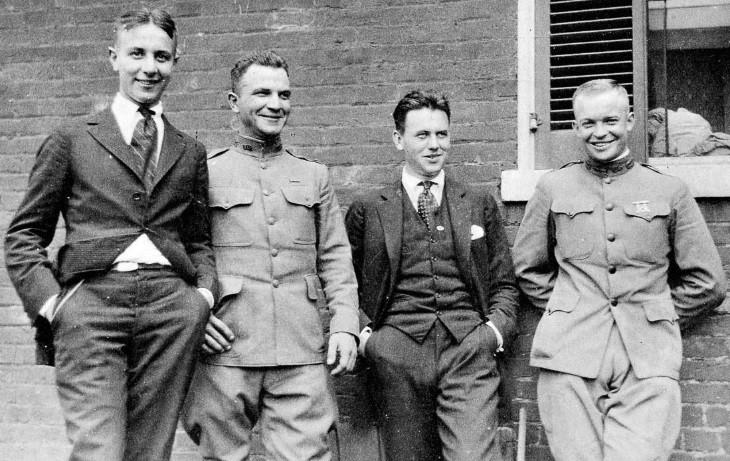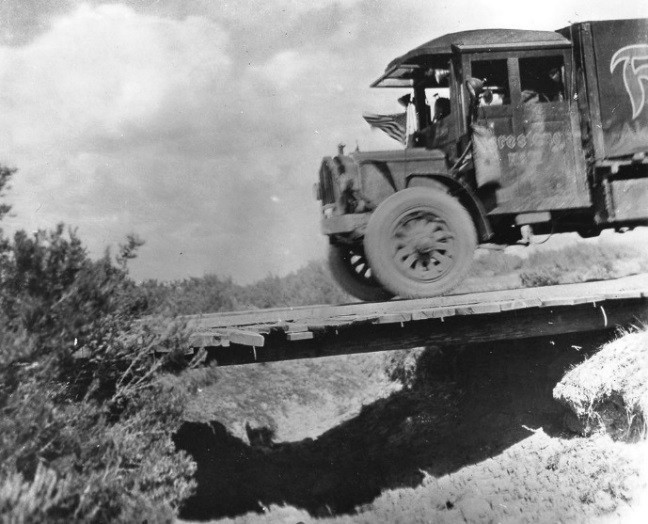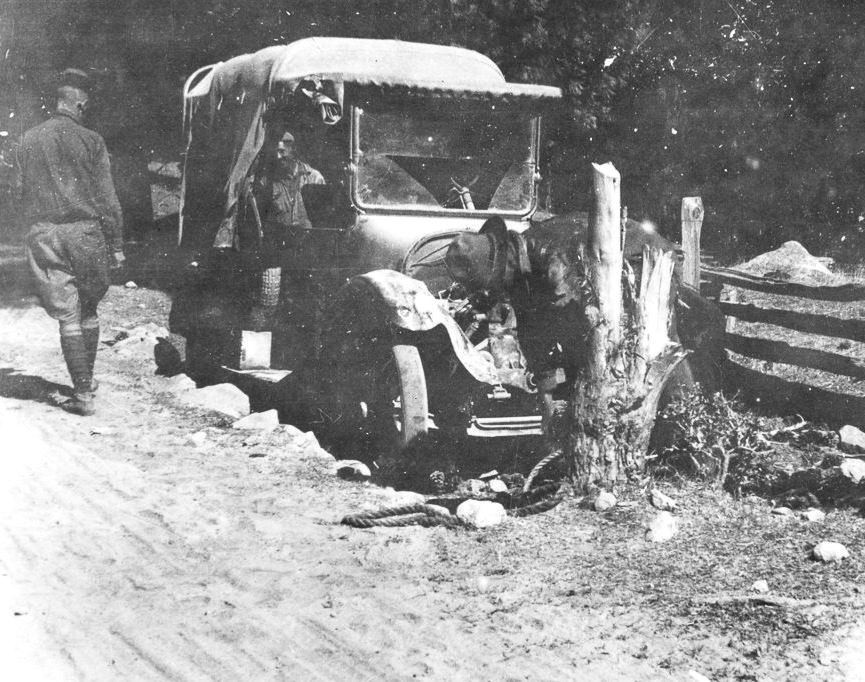By Daniel Stickney, INDOT Construction Cost Manager
INDOT is celebrating its 100th anniversary in July 2019. But did you know that July 2019 also marks the 100th anniversary of the U.S. Army’s first Transcontinental Motor Convoy, which crossed Indiana on the way from Washington, D.C., to San Francisco, stopping overnight at Fort Wayne and South Bend? Or that one of the 17 official observers who accompanied the convoy was a 28-year-old brevet lieutenant colonel named Dwight D. Eisenhower, who would go on to champion the interstate highway system as the 34th president of the United States?
At a July 13, 1919, stop of the convoy in Columbiana, Ohio, participants (from left, right photo) William Stuhler, Major Brett, Paul V. Robinson, and Dwight D. Eisenhower relax.
The first Transcontinental Motor Convoy set out from Washington on July 7, 1919, with 24 officers,
256 enlisted men and 17 observers. The convoy’s mission was to follow the newly designated Lincoln Highway (roughly today’s U.S. 30) to California to see if such a trip would be feasible in a national emergency. The convoy included 81 vehicles from 13 manufacturers ranging from Cadillac and Dodge passenger cars to 5½-ton Mack trucks, including at least three examples of every cargo truck being considered for Army service at the time.
Nine Indian and Harley-Davidson motorcycles were used for communications in those pre-telephone, pre-radio days. In keeping with the practice of the time, all of the vehicles were collectively referred to as “motors,” an obsolete turn of phrase that still lingers today in terms like “motor pool.” The convoy entered Indiana on July 17, 1919, just two days after the Indiana State Highway Commission (ISHC), the predecessor to INDOT, let its first state highway construction contracts.
According to the convoy’s official report, the primary reason for the trip was, “The War Department's contribution to the Good Roads Movement for the purpose of encouraging the construction of through-route and transcontinental highways as a military and economic asset.”
The same Good Roads Movement had led to the creation of the ISHC earlier that year. However, in 1919, “good roads” were mostly conspicuous by their absence. Anticipating hard traveling, the convoy included five ambulances, one truck-mounted blacksmith shop, two machine shops, one gasoline and two water tankers, four kitchen trailers, a 5-ton crawler tractor, a wheeled “artillery tractor” used as a wrecker, a searchlight, an electric power plant, and an entire company of engineers to repair and reinforce roads and bridges along the way. Two trucks were dedicated to carrying spare parts, and two others were provided by the Firestone Tire and Rubber Company to carry spare tires.
It was fortunate that they were so well prepared, because 100 years ago neither the roads nor the vehicles were anything like the trouble-free transportation that we take for granted today. There was a near-complete absence of road signs and highway markers.
The official log of the trip is a litany of accidents, ditchings, mechanical failures, bad roads, and worse bridges. Every bridge had to be inspected by the engineers before the trucks could be allowed to cross, and — even then — the heavier trucks often broke through. Many covered bridges were too small for the larger vehicles to pass through, leading to long detours to find better bridges or passable fords.
The vehicles were primitive and fragile, constantly suffering everything from coolant leaks and broken fan belts to broken transmissions and blown engines. The drivers were mostly new recruits and often caused breakdowns or accidents through inexperience; most of the officers had little or no experience in commanding soldiers in the field. On their best day, they covered 90 miles; on their worst day, only five. The six official “rest days” on the schedule were mostly spent making repairs.
Eisenhower hand-wrote captions to this photo: “Hoping it will  hold” on a bridge photo (left).
hold” on a bridge photo (left).
Along the way, they had to deal with severe weather, bad roads, bad gasoline, soft sand, and axle-deep mud while tackling steep hills in fully loaded vehicles with weak engines and even weaker brakes. Frames bent and suspensions broke from the constant pounding, and parts worked loose and fell off. Not a single day passed without at least one vehicle under tow; at one point, the artillery tractor was
towing nine broken-down trucks at once. Worst of all was the constant dust, which got into everything, plugging radiators, clogging carburetors, shorting out ignition systems, and wearing out bushings and bearings.
But it wasn’t all bad. Virtually everywhere they stopped, they received a grand reception with parades, parties, lunches, refreshments, band concerts and dinners, along with escorts in and out of town by local dignitaries and auto clubs.
Interestingly, the three days they spent crossing Indiana were some of the least eventful of the trip, with the roads from Delphos, Ohio, to Fort Wayne on July 17 described as “good, but dusty,” Fort Wayne to South Bend on July 18 as “generally good, few grades,” and South Bend to Chicago Heights, Ill., on July 19 as “fair but dusty.” (Note: Ten years later, in the ISHC 1929 annual report, dust was finally addressed: “The commission for the first time took cognizance of the dust nuisance, and by using calcium chloride and a light-grade oil, treated 650 miles, making them dustless and as comfortable for travel as the paved ways.”)
Along the way across Indiana, they suffered nine breakdowns, one flat tire, one broken bridge, one rollover accident because of inattentive driving, and one pedestrian struck (non-fatally) in Valparaiso. The only reason they didn’t have more flats is most of the vehicles were running on solid rubber tires. It took the convoy approximately 23½ hours traveling time to cover 207 miles during those three days from Delphos to Chicago Heights. The same trip would take about 3 hours, 35 minutes today.
On July 17, they were served refreshments in Churubusco and lunch in Fort Wayne after being escorted through Fort Wayne to their campsite in Lawton Park by the mayor, local postmaster, and assorted local dignitaries. Not to be outdone by Fort Wayne, on July 18 they were “met and escorted through South Bend by Major F.R. Carson, Chief of Police Peter Kline, Fire Chief I.A. Sorbell, Secretary of the Chamber of Commerce Jos. F. Kelly, a reception committee of prominent citizens, three fire companies, and two bands, furnished by the Chamber of Commerce and the Goodrich Co.” Finally, on July 19, they were escorted through LaPorte by the mayor and a reception committee before stopping in Valparaiso for yet another lunch served by the Chamber of Commerce and the Red Cross Canteen Service after yet another mayoral and reception committee escort.
Eisenhower hand-wrote c aptions to this photo: “Accident to a Dodge” on a crash photo (right). All photos from the Eisenhower Presidential Library.
aptions to this photo: “Accident to a Dodge” on a crash photo (right). All photos from the Eisenhower Presidential Library.
The convoy found Indiana roads good, if dusty. The report states, “The convoy arrived at Lexington, Neb., almost exactly halfway across the continent on Aug. 1, on time, thanks to the good roads of Pennsylvania, Ohio, Indiana and Illinois, and to the fact that the gumbo roads of Iowa were dry and hard. … From this point west, however, the roads grew steadily worse. … It became increasingly difficult to get the heaviest trucks through the soft, sandy roads and over the bad grades.”
It wasn’t until Sept. 7 that the convoy finally made it to San Francisco, six days behind schedule. The convoy covered 3,250 miles over 56 travel days at an average speed of 6 mph, recording more than 230 road accidents and innumerable mechanical breakdowns while breaking and repairing dozens of wooden bridges along the way — 14 bridges in Wyoming alone. Nine vehicles and 21 men failed to complete the trip for one reason or another.
The official report both indirectly acknowledged the creation of highway commissions like Indiana’s while presaging our current joint federal and state responsibility of creating and maintaining roads.
The report read: “All along the route, great interest in the Good Roads Movement was aroused by the passage of the convoy, and it was reported that several states had voted favorably on large issues of road bonds. However, the officers of the convoy were thoroughly convinced that all transcontinental highways should be constructed and maintained by the federal government, because the sparsely settled states of vast area in the Rocky Mountain region are absolutely unable to finance their own sections of such a project.”
Even so, it would take nearly 40 years, another world war, and the personal experience of seeing the German autobahn system before President Eisenhower would sign the Federal Aid Highway Act of 1956, fulfilling the U.S. Army’s first Transcontinental Motor Convoy’s vision of the state and federally funded interstate highway system we enjoy today.
Editor’s note: Daniel Stickney’s father owns a World War I surplus M1917 Four-Wheel Drive Auto Co. Model B truck similar to three that were used in the convoy, so he has a good idea how much maintenance those early trucks required and how much effort it would take to drive one across the country.
